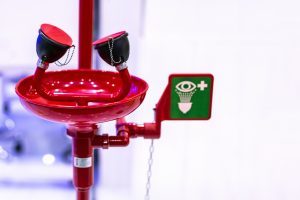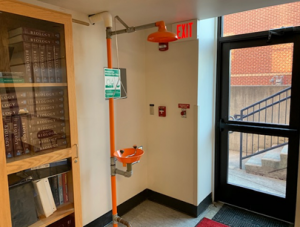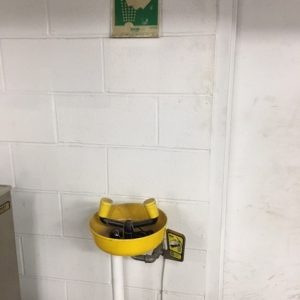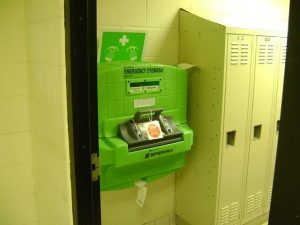Print a Sign-In Sheet | Spanish Version Coming Soon
Many have emergency eyewash and shower stations. If an employee’s body or eyes are exposed to a corrosive material, the equipment must be available for quick flushing and drenching of the body or eyes.
The eyewash and shower must be within the work area and accessible for emergency use. Eyewash and Shower equipment guidelines are set by the American National Standard (ANSI) Z358.1-1990 and adopted by Kentucky Standard General Industry 803 KAR 2:310.
Definitions (within the Standard)
- Corrosive – A chemical that causes visible destruction of, or irreversible alterations to living tissue to the exposure site.
- Irritant – A chemical (not a corrosive) that causes a reversible inflammatory effect on living tissue to the exposure site. Chemicals that cause irritation are not required to provide eyewash/shower stations under these standards.
- Plumbed unit – Connected to a constant water line.
- Self-contained – A unit that stores water and does not have a constant water line.
- Combination unit – An eyewash and shower combined into one common assembly.
- Thermostatic mixing valve – A valve installed in the water line that makes the temperature of the water passing through it within a set range. This makes sure that the water is not too hot or too cold.
Requirements
- Eyewash/shower station must be a maximum of 10 seconds or 40 feet from the potential exposure of corrosives. Doorways should not be blocked or locked.
- Eyewash/shower stations should be well-lit and identified by a visible sign.
- Make sure eyewash/shower stations are not blocked or have items stacked on top of them.
- If you have a battery charging area and add electrolyte for your powered industrial trucks, you must have an eyewash/shower station in the area in case of an incident.
- Water should be able to flow within one second or less of initiating the eyewash/shower station.
- The flow rate must be 1.5 liters a minute for 15 minutes.
- When in use, water shall remain flowing without the operator’s use of hands. (e.g., foot pedal, pull cord, or hand pedal with continuous flow after pressed).
- Spray nozzles should be protected with caps or coverings so they are free from dust and contaminants.
- The water flow shall be low velocity and the water temperature shall not be too hot or cold so it does not injure the eyes.
- A shower’s head should be 82 to 96 inches from the surface that the employee is standing on.
- Plumbed showers should produce 30 gallons a minute and self-contained units should produce 20 gallons a minute of water for 15 minutes.
- Eyewash stations and showers shall be tested monthly to make sure they are fully operational. They must be cleaned regularly.
- Sinks (without attached sprayers) and portable water or saline bottles are not approved emergency eyewash equipment.
 |
 |
 |
|
Eyewash/Shower |
Eyewash |
Self-Contained Unit |
KEMI does not assume liability for the content of information contained herein. Safety and health remain your responsibility. This information is to be used for informational purposes only and not intended to be exhaustive or a substitute for proper training, supervision, or manufacturers’ instructions/recommendations. KEMI, by publication of this information, does not assume liability for damage or injury arising from reliance upon it. Compliance with this information is not a guarantee or warranty that you will be in conformity with any laws or regulations nor does it ensure the absolute safety of any person, place, or object, including, but not limited to, you, your occupation, employees, customers, or place of business.

